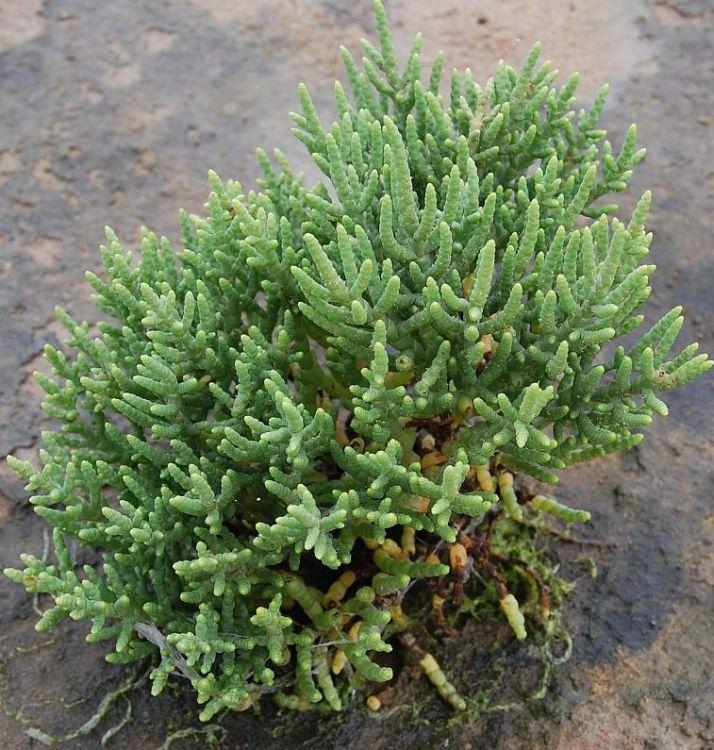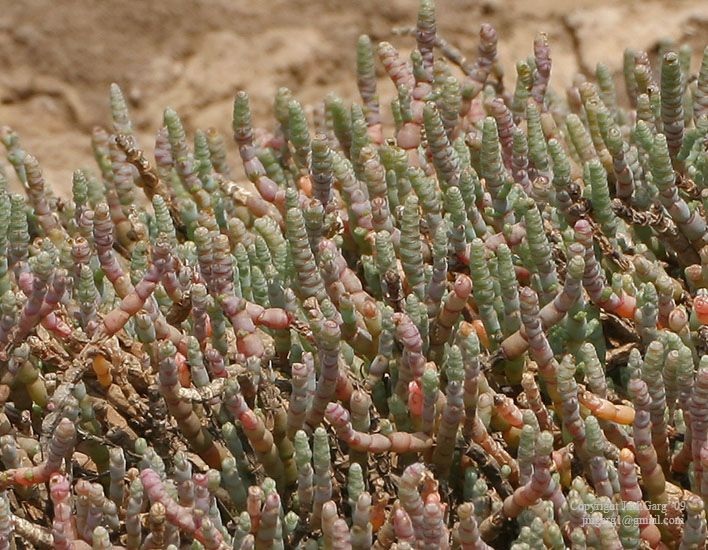Salicornia brachiata Roxb. (syn: Arthrocnemum indicum Thw.); India, Sri Lanka, Myanmar [Burma] (Rakhine), Bangladesh as per Catalogue of Life;
Aquatic plant | ID Request 06Apr10AR02 : 11 posts by 7 authors. Attachments (4) Date/Time-5 Aug 2006 3.11 PM Location- Place, Altitude, GPS- Pulicat Lake, Chennai, Habitat- Garden/ Urban/ Wild/ Type-Wild, Lagoon P lant Habit- Tree/ Shrub/ Climber/ Herb- Aquatic plant Height/Length-approx – 0.5 feet The plant you posted is Arthrocnemum sp. This should be A. indicum or else A. glaucum. Arthrocnemum indicum, A. glaucum or A.subterminale Perish’s Glasswort Chenopodiaceae Tamil name: Kolliam, Pavazhappoondu The generic name of the plant came from the appearance of a combination of Arthopods and Nematodes. Very interesting plant It should be Arthrocnemum macrostachyum (Moric.) C. Koch (A. indicum (Willd.) Moq. subsp. glaucum (Ungern-Sternb.) Maire & Weiller in Maire A. indicum is matforming plant this species is erect and robust as seen in photograph. Though most of the reports available on internet suggests that Arthrocnemum species growing around Pulicat lake is A indicum but as said by … I too think this plant is Arthrocnemum macrostachyum due to its habit which is much much robust than that of A indicum. this plant reminds me of an Aquatic plant seen frequently and in abundance at the north see. the German name is queller http://de.wikipedia.org/wiki/Salicornia_europaea (unfortunately did not find an Eng. site). As it grows at the see, it is salty, contains many minerals, can be used in salads and even “pickles” are made from this. very tasty. i wonder if … plant is edible too! attaching some pictures taken by me, in okt 09 in a place called Cuxhaven, on the north see. i hope i am not breaking any rules by sending information about non-indian plants. Attachments (2) The plant you are referring to is known as Salicornia europaea L. from the family Chenopodiaceae commonly known as glasswort found growing in the tidal region but I didn’t came across any reports which tells me that this particular plant has been reported from Pulicat Lake in Chennai though it has been reported from India. Hence I cant nullify your suggestion because this may be a new introduced species around the lake region and looks very similar to Arthrocnemum macrostachyum . I will earnestly request and wait for the experts to comment and help in solving the identity of this halophytic plant from the Pulicat lake Chennai. For Id 190309JM1 : 6 posts by 3 authors. Attachments (2) Seen in the mangroves in the dry tracts of islands. It looks like Salicornia sp. This is Salicornia spp. a succulent Appears like Arthrocnemum macrostachyum ? It should be Arthrocnemum indicum Thw. syn. of Salicornia brachiata Roxb. as per POWO 190713 ASP 121 : Attachments (1). 6 posts by 3 authors. Please ID this succulent that grows along brackish water coast. Photo was taken in Sri Lanka in Dec 2011. Salicornia sp.? It looks like sueada sp. member of Chenopodiaceae. Yes, It looks like Salicornia brachiata. References: |
Salicornia brachiata
Updated on December 24, 2024






